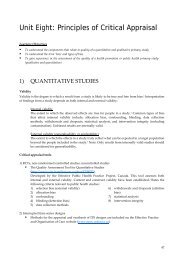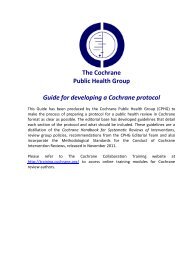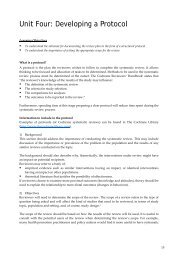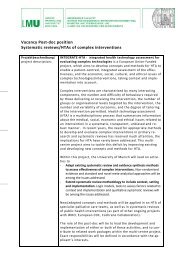Train the Trainer Course book - Cochrane Public Health Group
Train the Trainer Course book - Cochrane Public Health Group
Train the Trainer Course book - Cochrane Public Health Group
You also want an ePaper? Increase the reach of your titles
YUMPU automatically turns print PDFs into web optimized ePapers that Google loves.
Unit Four: Developing a Protocol<br />
Learning Objectives<br />
To understand <strong>the</strong> rationale for documenting <strong>the</strong> review plan in <strong>the</strong> form of a structured protocol<br />
To understand <strong>the</strong> importance of setting <strong>the</strong> appropriate scope for <strong>the</strong> review<br />
What is a protocol?<br />
A protocol is <strong>the</strong> plan <strong>the</strong> reviewers wishes to follow to complete <strong>the</strong> systematic review. It allows<br />
thinking to be focused and allocation of tasks to be determined. Methods to be used in <strong>the</strong> systematic<br />
review process must be determined at <strong>the</strong> outset. The <strong>Cochrane</strong> Reviewers’ Hand<strong>book</strong> 1 states that<br />
“<strong>the</strong> reviewer’s knowledge of <strong>the</strong> results of <strong>the</strong> study may influence:<br />
The definition of <strong>the</strong> systematic review<br />
The criteria for study selection<br />
The comparisons for analyses<br />
The outcomes to be reported in <strong>the</strong> review.”<br />
Fur<strong>the</strong>rmore, spending time at this stage preparing a clear protocol will reduce time spent during <strong>the</strong><br />
systematic review process.<br />
Information to include in <strong>the</strong> protocol<br />
Examples of protocols (of <strong>Cochrane</strong> systematic reviews) can be found in The <strong>Cochrane</strong> Library<br />
(http://www.<strong>the</strong>cochranelibrary.com).<br />
1) Background<br />
This section should address <strong>the</strong> importance of conducting <strong>the</strong> systematic review. This may include<br />
discussion of <strong>the</strong> importance or prevalence of <strong>the</strong> problem in <strong>the</strong> population and <strong>the</strong> results of any<br />
similar reviews conducted on <strong>the</strong> topic.<br />
The background should also describe why, <strong>the</strong>oretically, <strong>the</strong> interventions under review might have<br />
an impact on potential recipients.<br />
Reviewers may refer to a body of:<br />
empirical evidence such as similar interventions having an impact, or identical interventions<br />
having an impact on o<strong>the</strong>r populations.<br />
<strong>the</strong>oretical literature that justifies <strong>the</strong> possibility of effectiveness.<br />
If reviewers choose to examine more proximal outcomes (knowledge and attitudes), <strong>the</strong>ory should be<br />
used to explain <strong>the</strong> relationship to more distal outcomes (changes in behaviour).<br />
2) Objectives<br />
Reviewers will need to determine <strong>the</strong> scope of <strong>the</strong> review. The scope of a review refers to <strong>the</strong> type of<br />
question being asked and will affect <strong>the</strong> kind of studies that need to be reviewed, in terms of study<br />
topic, population and setting, and, of course, study design. 2<br />
The scope of <strong>the</strong> review should be based on how <strong>the</strong> results of <strong>the</strong> review will be used. It is useful to<br />
consult with <strong>the</strong> potential users of <strong>the</strong> review when determining <strong>the</strong> review’s scope. For example,<br />
many health promotion practitioners and policy makers would find it more useful to have systematic<br />
27








